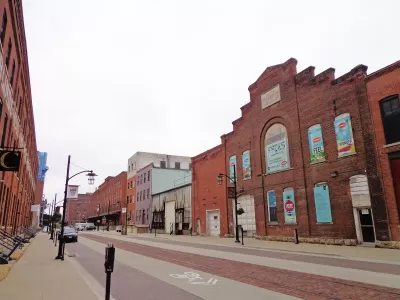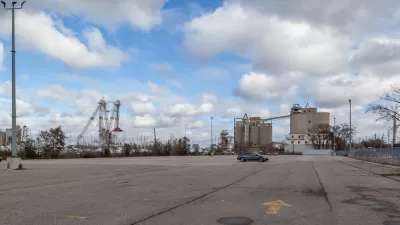The Historic Millwork District Master Plan, approved in 2009, provides exemplary solutions in historic preservation, parking requirements, and environmental standards, all now rewarding the city of Dubuque, Iowa with economic development.

Decades of planning for a once-blighted section of Dubuque, Iowa are bearing fruit. The strategies supporting The Historic Millwork District Master Plan illustrate ways to create high economic value with low environmental impact by repurposing nearly a million square feet of old buildings and creating new energy-efficient infrastructure.
Dubuque's Millwork District lies between Downtown Dubuque and the Mississippi River. Once the nation’s largest Millwork zone, it covers 19 acres with over one million square feet of vacant warehouse space. The adjacent 128-acre Washington Neighborhood is also one of the city's oldest communities, and it is enjoying revitalization as well.
The Millwork District is one of Iowa's largest intact collections of historic structures. Although most of the buildings have been marginally occupied over the past 50 years, the Plan preserves and reuses the bulk of them for creative-class, residential, and commercial ventures, retaining the District's unique character and forging a link to Dubuque's great industrial past. And it allows redevelopment to proceed sustainably, with a "complete streets" program that prioritizes transit, walking and biking over car traffic.

The first phases of development recently opened, with renovations to the former CARADCO building by Gronen Properties. CARADCO Lofts contains 72 units of housing, 15,000 square feet of retail, restaurant, and office space. Prior to opening CARADCO Lofts, the city rebuilt all the streets and committed to locating a multi-modal facility for buses and Amtrak in the District. A second renovation, similar in size to CARADCO is currently under construction and slated to open within a year.

Cuningham Group Architecture, Inc. authored the Dubuque Millwork District Master Plan. It established the design parameters working with AECOM's financial plan, which projected the return on investment. Also partnering were the city of Dubuque and area land owners, who jointly funded the project, securing funds, for example, from the Iowa state government with the support of Dubuque’s private developers.
The city’s foresight in preserving the treasured structures of the Millwork District was recently recognized by the U.S. Environmental Protection Agency (EPA), which awarded the area, along with six other communities, a National Award for Smart Growth Achievement, based on its effectiveness in "creating a sustainable community, showcasing innovative planning, initiating vigorous public involvement, generating public/private/non-profit partnerships, and serving as a prototype to other communities."
The plan has also received several other recognitions, including;
- 1000 Friends of Iowa Best Development Awards - Leadership Category, 2009
- Iowa Chapter of the American Planning Association Planning Excellence Award - Innovation in Best Practices for Sustainability, 2009
- Dubuque Main Street 24th Annual Awards - Best Community Initiated Development, 2009
Among the difficulties the master plan solved was parking. Old buildings cover a lot of ground, and their previous uses did not require the number of parking spaces residences and retail tenants demand. But the city worked with Amtrak to locate a train stop in Dubuque and secured funding for a parking structure shared by train passengers and Millwork District tenants.
Dubuque's rebirth is in part due to its unique setting and history. Set beneath the bluffs of the Mississippi River in the Driftless Region of Eastern Iowa, Dubuque's landscape is hilly and rocky—not the typical Midwestern prairie. The landscape is full of visual interest and makes a beautiful natural setting for urban living. Also, the Federal Interstate highway system of the 1950s bypassed downtown Dubuque, keeping sprawl at bay and helping to preserve the District’s great stock of old of buildings.
Today, with projects such as the Millwork Plan in place, Dubuque enjoys a low 3.5 percent unemployment rate, with a new creative district emerging as a model for future public-private partnerships across the country.
Cuningham Group Urban Designer Andrew Dresdner led the team that created the Historic Millwork District Master Plan.

Alabama: Trump Terminates Settlements for Black Communities Harmed By Raw Sewage
Trump deemed the landmark civil rights agreement “illegal DEI and environmental justice policy.”

Study: Maui’s Plan to Convert Vacation Rentals to Long-Term Housing Could Cause Nearly $1 Billion Economic Loss
The plan would reduce visitor accommodation by 25% resulting in 1,900 jobs lost.

Planetizen Federal Action Tracker
A weekly monitor of how Trump’s orders and actions are impacting planners and planning in America.

Wind Energy on the Rise Despite Federal Policy Reversal
The Trump administration is revoking federal support for renewable energy, but demand for new projects continues unabated.

Passengers Flock to Caltrain After Electrification
The new electric trains are running faster and more reliably, leading to strong ridership growth on the Bay Area rail system.

Texas Churches Rally Behind ‘Yes in God’s Back Yard’ Legislation
Religious leaders want the state to reduce zoning regulations to streamline leasing church-owned land to housing developers.
Urban Design for Planners 1: Software Tools
This six-course series explores essential urban design concepts using open source software and equips planners with the tools they need to participate fully in the urban design process.
Planning for Universal Design
Learn the tools for implementing Universal Design in planning regulations.
Caltrans
Smith Gee Studio
Institute for Housing and Urban Development Studies (IHS)
City of Grandview
Harvard GSD Executive Education
Toledo-Lucas County Plan Commissions
Salt Lake City
NYU Wagner Graduate School of Public Service





























